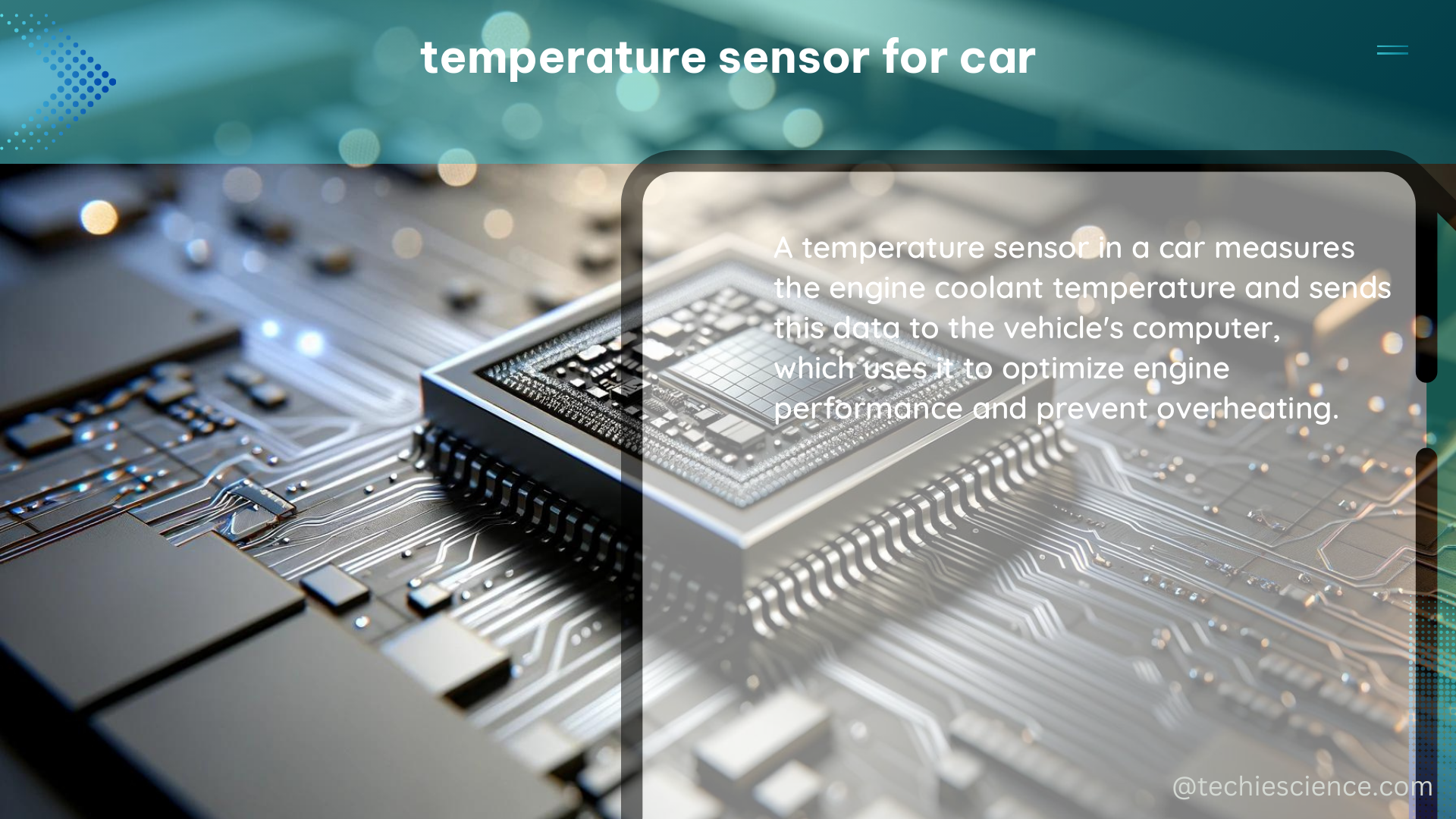Temperature sensors are crucial components in modern automobiles, responsible for monitoring and controlling the temperature of various systems and components. These sensors come in diverse types, including thermocouples, RTDs (Resistance Temperature Detectors), and thermistors, each with its own unique characteristics and applications. In this comprehensive guide, we will delve into the intricacies of temperature sensors for cars, exploring their functionality, types, and use cases.
Types of Temperature Sensors for Cars
Thermocouples
Thermocouples are the most common type of temperature sensor used in automotive applications. They work on the principle of the Seebeck effect, where two dissimilar metals are joined, and a voltage is generated proportional to the temperature difference between the two junctions. Thermocouples offer a wide temperature range, high accuracy, and excellent durability, making them suitable for engine, exhaust, and other high-temperature measurements.
Resistance Temperature Detectors (RTDs)
RTDs are another type of temperature sensor that utilize the change in electrical resistance of a metal, typically platinum, to measure temperature. RTDs offer higher accuracy and stability compared to thermocouples, but they are more expensive and have a narrower temperature range. RTDs are often used in applications where precise temperature monitoring is critical, such as in engine coolant systems.
Thermistors
Thermistors are temperature-sensitive resistors that exhibit a significant change in resistance with a change in temperature. They are available in both positive temperature coefficient (PTC) and negative temperature coefficient (NTC) varieties. Thermistors are known for their high sensitivity, fast response time, and low cost, making them suitable for applications such as cabin temperature monitoring and engine oil temperature sensing.
Temperature Sensor Locations in Cars

Temperature sensors in cars are strategically placed to monitor the temperature of various systems and components, including:
- Engine Coolant Temperature (ECT) Sensor: Measures the temperature of the engine coolant, which is crucial for engine management and cooling system control.
- Intake Air Temperature (IAT) Sensor: Measures the temperature of the air entering the engine, which is used to optimize the air-fuel ratio and improve engine performance.
- Exhaust Gas Temperature (EGT) Sensor: Measures the temperature of the exhaust gases, which is important for monitoring the performance of the catalytic converter and engine combustion.
- Transmission Fluid Temperature Sensor: Measures the temperature of the transmission fluid, which is essential for monitoring the health and performance of the transmission system.
- Tire Temperature Sensor: Measures the temperature of the tires, which can be used to detect potential issues, such as uneven tire wear or underinflation.
- Cabin Temperature Sensor: Measures the temperature inside the vehicle’s cabin, which is used to control the climate system and ensure passenger comfort.
Advanced Temperature Sensor Technologies
In addition to the traditional sensor types, the automotive industry has also embraced more advanced temperature sensor technologies, such as the TMP275-Q1 Automotive Grade ±0.75°C Temperature Sensor from Texas Instruments.
The TMP275-Q1 is a digital temperature sensor that offers several key features:
- High Accuracy: ±0.75°C (Maximum) from −10°C to +85°C
- Wide Temperature Range: -40°C to +125°C
- Low Supply Voltage: 2.7 V to 5.5 V
- Small Footprint: 8-pin SOIC and VSSOP packages
- No External Components Required
- Programmable Resolution: 0.0625°C (12 bits) to 0.5°C (9 bits)
- SMBus and Two-Wire Interface Compatibility
- Overtemperature Alert Function
This sensor is particularly well-suited for temperature compensation of other sensors and electronic components, as it eliminates the need for additional system-level calibration or complex board layouts for distributed temperature sensing.
Challenges in Outside Temperature Measurement
While temperature sensors in cars are generally accurate, the measurement of outside air temperature can be challenging due to the sensor’s location. Typically, the outside temperature sensor is placed under the front of the hood, near the bottom of the car. This location causes the sensor to pick up heat from the road surface, leading to readings that are several degrees higher than the actual air temperature.
This issue is particularly noticeable when driving on high-speed highways, where the road surface not only absorbs heat from the sun but also from the car’s tires. To mitigate this problem, some car manufacturers have implemented algorithms to compensate for the heat absorption, providing a more accurate representation of the outside air temperature.
Conclusion
Temperature sensors are essential components in modern automobiles, playing a crucial role in monitoring and controlling the temperature of various systems and components. From traditional thermocouples and RTDs to advanced digital sensors like the TMP275-Q1, the automotive industry has a wide range of temperature sensor technologies at its disposal. Understanding the different types of sensors, their applications, and the challenges in outside temperature measurement is crucial for maintaining the optimal performance and efficiency of a vehicle.
References:
- Dewesoft. (2023-02-03). Temperature Measurement on a Racing Car | Dewesoft. Retrieved from https://dewesoft.com/blog/temperature-measurement-on-a-racing-car/
- Texas Instruments. (November 2015; Revised April 2017). TMP275-Q1 Automotive Grade ±0.75°C Temperature Sensor with I2C and SMBus Interface in Industry-Standard LM75 Form Factor and Pinout. Retrieved from https://www.ti.com/lit/ds/symlink/tmp275-q1.pdf?ts=1709859649102
- Mechanics.stackexchange.com. (2012-08-26). How is “outside temperature” measured in a car? Retrieved from https://mechanics.stackexchange.com/questions/4215/how-is-outside-temperature-measured-in-a-car

The lambdageeks.com Core SME Team is a group of experienced subject matter experts from diverse scientific and technical fields including Physics, Chemistry, Technology,Electronics & Electrical Engineering, Automotive, Mechanical Engineering. Our team collaborates to create high-quality, well-researched articles on a wide range of science and technology topics for the lambdageeks.com website.
All Our Senior SME are having more than 7 Years of experience in the respective fields . They are either Working Industry Professionals or assocaited With different Universities. Refer Our Authors Page to get to know About our Core SMEs.